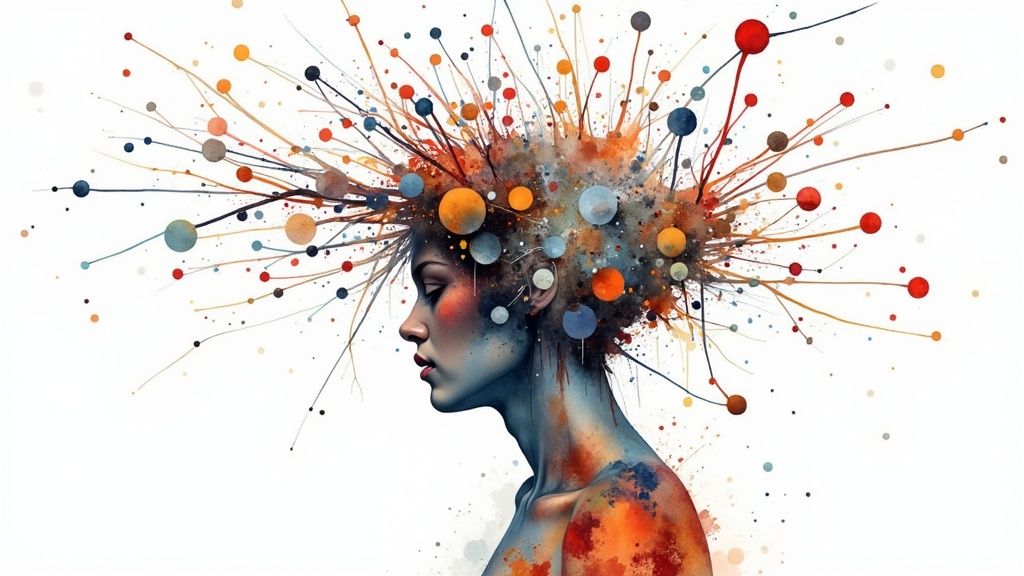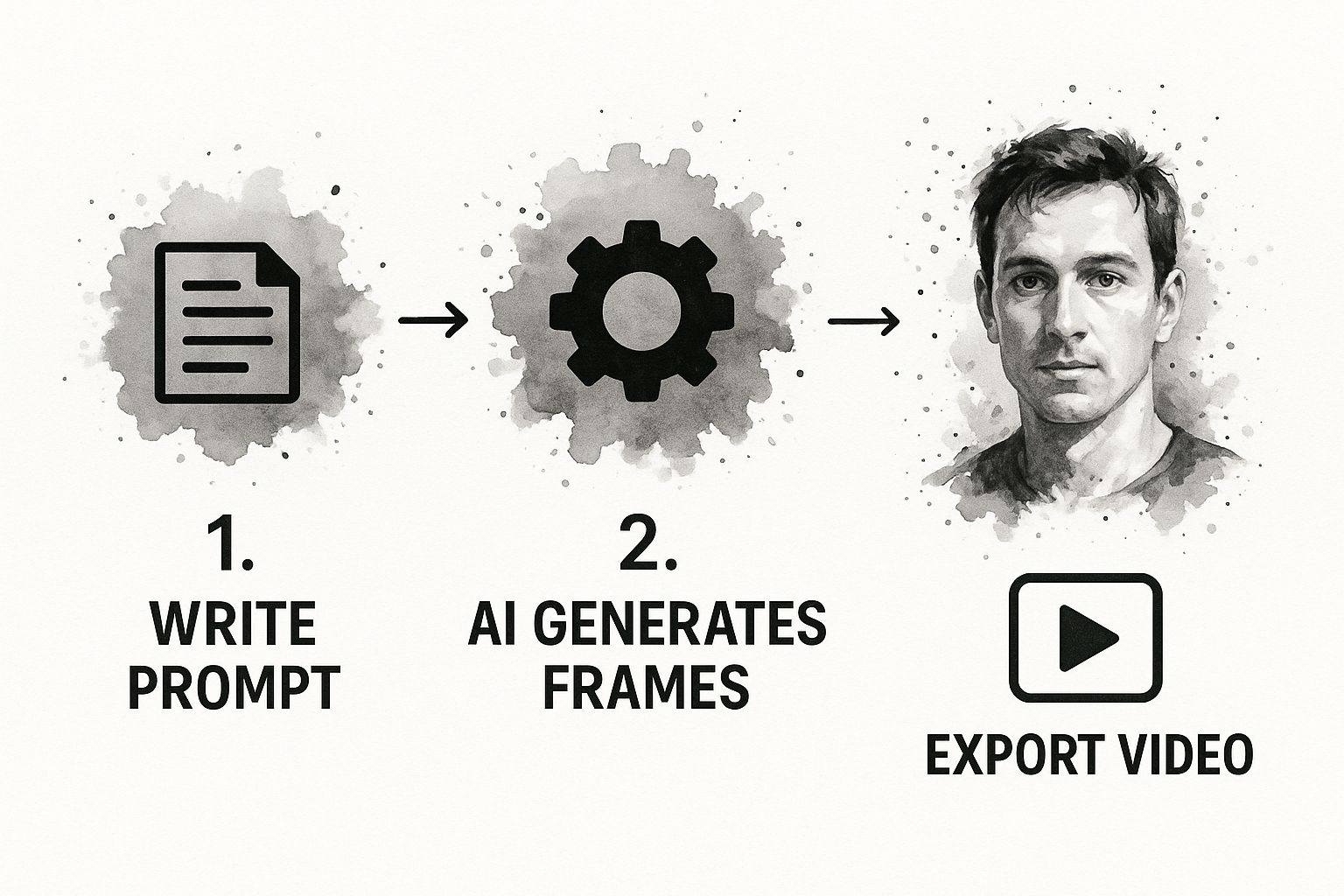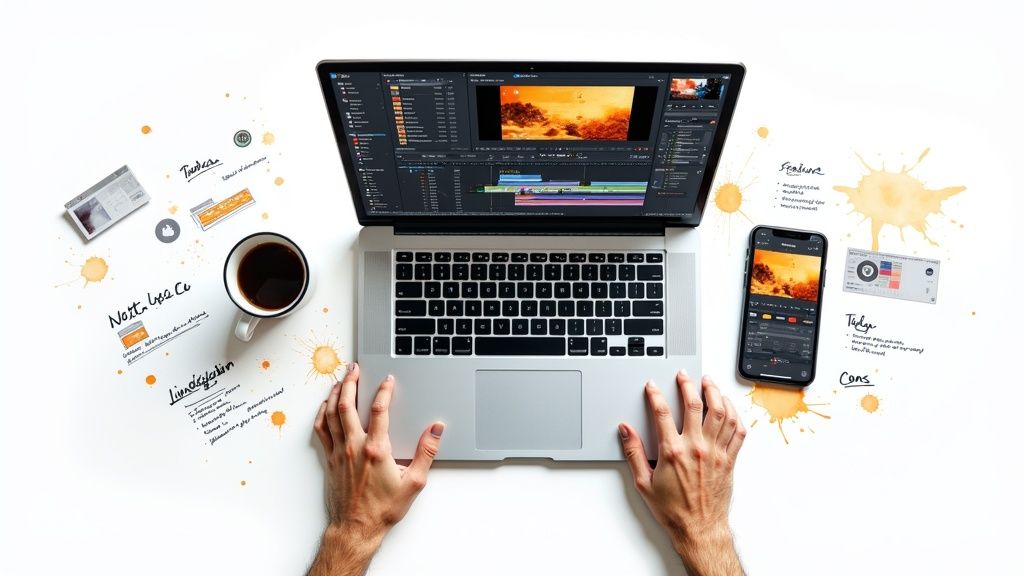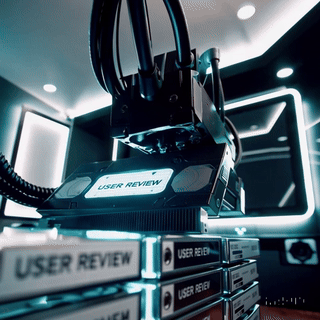In This Article
Subscribe to our newsletter
Making Sense of AI Text to Video Technology
 This screenshot shows the interface of DALL-E 2, an AI image generator. Notice the simple text prompt area and the detailed visuals it creates. This demonstrates how AI can turn abstract ideas into visual form, a key principle behind AI text-to-video.
This screenshot shows the interface of DALL-E 2, an AI image generator. Notice the simple text prompt area and the detailed visuals it creates. This demonstrates how AI can turn abstract ideas into visual form, a key principle behind AI text-to-video.
Imagine having a film director inside your computer, bringing your words to life. That's the essence of AI text-to-video technology. But it's more than just animating sentences. Like a skilled editor, it interprets the nuances of your writing, understanding the emotional tone and narrative flow.
This allows the AI to make smart choices about pacing, visuals, and even camera angles. For example, tense moments might be shown as a fast-paced montage with close-ups. A peaceful scene could be depicted with slow, sweeping shots of a tranquil landscape.
This ability to grasp context and emotion is what sets apart basic text-to-video conversion from truly captivating visual stories.
Before diving into video, understanding AI in content creation is helpful. For a complete overview, see this article on AI for Content Creation. The quality of the video depends heavily on the input you provide. A well-written prompt, full of descriptive language and a clear narrative structure, will likely produce something much more impressive than a jumble of disconnected clips.
The User's Role in AI Text-to-Video
Early users of AI text-to-video tools are already seeing these nuances in action. Some carefully crafted prompts produce surprisingly realistic and emotionally resonant videos. Others, lacking the same narrative depth, yield less impressive results.
This highlights the user's vital role in the creative process. You're not just typing text; you're guiding the AI's creative vision. Check out this resource on the Top 10 Best AI Video Generators for 2025. It becomes a collaborative effort between human creativity and artificial intelligence. This understanding is key to unlocking the technology's full potential.
The Creative Engine Behind AI Video Generation
 This screenshot showcases TensorFlow, an open-source machine learning platform. The highlighted sections demonstrate the breadth of tools and resources available for developers working with AI, including those building AI text-to-video technology. These complex systems rely on frameworks like TensorFlow to process and learn from vast amounts of data.
This screenshot showcases TensorFlow, an open-source machine learning platform. The highlighted sections demonstrate the breadth of tools and resources available for developers working with AI, including those building AI text-to-video technology. These complex systems rely on frameworks like TensorFlow to process and learn from vast amounts of data.
Think of AI text-to-video as a universal translator, fluent not just in different languages, but in different forms of communication: text, emotions, visuals, and even timing.
This "translation" begins with machine learning models analyzing your written content. Imagine a literary critic carefully dissecting a novel, identifying core themes, emotional nuances, and the overall narrative arc. That's what these models do with your text.
AI text-to-video is also a form of automated content creation. This means the AI isn’t throwing together random visuals. Instead, it makes deliberate choices based on the story you want to tell.
From Text to Visual Storytelling
Once the AI understands your story, it switches roles from literary critic to cinematographer. It starts connecting the themes and emotions it identified to corresponding visual styles.
For example, a story about overcoming adversity might be visualized with soaring landscapes and vibrant colors. On the other hand, a story about loss might use darker hues, close-up shots, and a slower pace.
This intricate transition from text to visuals is powered by neural networks. These are complex algorithms designed to mimic the way the human brain works. They process your prompts and learn the often subtle relationships between words and visual concepts. Essentially, they build a vast library of which phrases evoke specific visual responses, allowing them to generate scenes that accurately reflect your text's tone and meaning.
The Nuances of AI Interpretation
The sophistication of these neural networks explains the wide range of output quality in AI video generation. Why do some text prompts result in stunning, almost Hollywood-level sequences, while others fall flat? It all comes down to data. The more data the AI has been trained on, the better it understands the nuances of language and visual storytelling.
Think of it like a chef learning to cook. The more recipes they try and the more ingredients they experiment with, the more refined their dishes become. Similarly, AI platforms that produce more polished videos have simply had more "practice" translating text into compelling visuals.
This also explains why crafting effective prompts is so crucial. It's an art form in itself, requiring a deep understanding of how the AI “thinks” and what kind of input yields the best results. Guiding the AI’s creative process is essential to unlocking the full potential of this exciting technology.
To better grasp the inner workings of these systems, let's delve into the core technologies at play. The following table provides a breakdown of the key components within AI text-to-video platforms.
Core AI Technologies in Text-to-Video Systems
| Technology | Function | Impact on Output Quality | Processing Time |
|---|---|---|---|
| Natural Language Processing (NLP) | Understands and interprets the meaning of text input | Directly influences how accurately the visuals reflect the text | Can vary based on complexity of input |
| Computer Vision | Analyzes and understands image and video content | Essential for creating visually coherent and realistic outputs | Often a significant portion of the overall processing time |
| Generative Adversarial Networks (GANs) | Generates new visual content based on the interpreted text | Key to the creative output; more sophisticated GANs lead to higher quality | Computationally intensive, influencing overall speed |
| Diffusion Models | Creates images by iteratively refining noise patterns based on text guidance | Often produces high-fidelity and detailed outputs | Generally slower than some other generative models |
| Neural Rendering | Creates 3D scenes and animations from text descriptions | Allows for complex camera movements and realistic lighting | Can be very computationally intensive |
This table highlights the interplay between different AI technologies and their impact on the final video. While NLP focuses on understanding your text, Computer Vision, GANs, Diffusion Models, and Neural Rendering work together to create the visual elements. The processing time for each component contributes to the overall speed of video generation. As these technologies advance, we can expect even more impressive and faster AI video creation.
Why Everyone's Talking About AI Video Creation

This Statista snapshot shows just how much data is swirling around about AI. It's a visual reminder of the intense activity and growth happening in the field. This wealth of information signals real interest and significant investment, highlighting AI's increasing importance across various industries.
Imagine a world where creating professional videos is suddenly within everyone's reach, without breaking the bank. That's the reality unfolding right now. This accessibility levels the playing field, letting smaller businesses stand shoulder-to-shoulder with industry giants. Teachers can build engaging lessons, and creators can boost their output significantly. But what's behind this rapid rise? It's more than just shiny new tech.
The boom in AI text-to-video marks a real turning point in content creation. Investment is pouring in, and early adopters are seeing tangible returns. The big question becomes: how does this impact traditional video production? This shift in technology sparks both excitement and a healthy dose of reflection within the industry.
Beyond The Hype: The Practical Appeal of AI Video
The market's response is loud and clear. This isn't a ripple; it's a wave. For instance, the AI text-to-video market is predicted to leap from $0.31 billion in 2024 to $0.4 billion in 2025. That's rapid adoption. Looking ahead, the projected value hits $1.18 billion by 2029, underlining AI's potential in video production. Discover more insights. This level of growth signals a fundamental change in how we create video content.
What's more, different sectors are finding innovative ways to use AI-generated video. From marketing to education, the applications seem limitless. How can businesses connect with their audiences through AI video? How can educators make learning more immersive? These are the areas where the practical strength of AI text-to-video truly shines.
The Future of Video Creation
We're seeing key players emerge, shaping this new world. Existing video production companies are adapting, and new startups are popping up, all competing for a piece of this growing market. This creates a dynamic landscape that drives innovation and pushes the boundaries of what AI video can achieve.
So, what's in store for creators and businesses? This swift growth presents both opportunity and a new set of challenges. This leads us to examine the ways AI is changing the way we create content, impacting workflows, and shifting the economic landscape of video production.
Mastering the AI Video Creation Process

This infographic shows the simple three-step process of AI text-to-video generation: write a prompt, let the AI generate the frames, and export the finished video. It’s remarkably efficient, taking you from concept to a complete video quickly. For publishers looking to transform written content, check out this helpful resource: Turn Articles into Videos: Easy Content Transformation Tips.
Creating great AI videos isn't just about pushing a button. Think of it like learning to cook – you need the right tools and techniques. It's a blend of technical know-how and good old-fashioned storytelling.
Crafting Effective Prompts for AI Text-to-Video
Your journey starts with the prompt. This isn't just a few keywords; it's the DNA of your video's story. A well-written prompt guides the AI, leading to better results.
Clear Narrative: Think about the story's backbone. Who are the key players? Where does it take place? What's the core message?
Visual Descriptions: Paint a picture with your words. Describe the mood, colors, and even the visual style you're aiming for.
Keywords and Phrases: Relevant keywords are helpful, but don't just cram them in. Prioritize clarity and narrative flow.
Emotional Tone: What feeling do you want to evoke? Uplifting? Serious? Funny? Your prompt should reflect that.
 This screenshot showcases the Figma design interface, a tool often used by creative professionals. While AI generates visuals, understanding design principles, like those used in Figma, can significantly improve your final product.
This screenshot showcases the Figma design interface, a tool often used by creative professionals. While AI generates visuals, understanding design principles, like those used in Figma, can significantly improve your final product.
Refining and Optimizing Your AI-Generated Video
After the AI generates your video, the real crafting begins. This is the refinement stage, where good becomes great. It's like editing a first draft.
Review and Adjust: Watch your video with a critical eye. Do the visuals match your vision? Does the pacing work? Is the story clear?
Iterate on Your Prompt: If the output isn't quite there, revise your prompt. Experiment with different wording and descriptions.
Utilize Editing Tools: Most AI video platforms offer editing tools. These allow you to fine-tune elements like music, voiceovers, and individual scenes. Some platforms even offer AI-powered text editing, letting you type commands like, "make this scene brighter."
Consider Style and Length: Think about your audience and platform. Shorter videos might be better for social media, while longer formats suit educational content.
This iterative process is key to achieving professional quality. To better understand the different workflows in video creation, take a look at the table below.
To help visualize the difference in workflow between traditional and AI-assisted video creation, let's examine a comparison table. This table illustrates how AI streamlines each step, leading to significant time savings.
AI Text-to-Video Workflow Comparison
Step-by-step comparison of workflows across different AI video generation platforms
| Workflow Step | Traditional Method | AI-Assisted Method | Time Savings | Quality Considerations |
|---|---|---|---|---|
| Concept & Scripting | Brainstorming, storyboarding, scriptwriting (Days/Weeks) | Text prompt creation (Minutes/Hours) | Significant (Days/Weeks) | Prompt clarity impacts visual accuracy |
| Visual Creation | Filming, animation, graphic design (Days/Weeks) | AI generates visuals based on prompt (Minutes/Hours) | Significant (Days/Weeks) | Refinement and editing may be needed |
| Editing & Post-Production | Video editing, sound design, effects (Days/Weeks) | AI platform editing tools, fine-tuning (Hours/Days) | Moderate (Hours/Days) | Familiarity with AI tools improves results |
| Distribution | Rendering, uploading to platform (Hours) | Export and direct upload options (Minutes) | Minor (Minutes/Hours) | Platform compatibility and optimization |
Key takeaway from this comparison: AI significantly accelerates the video creation process, especially in the initial stages. While quality considerations remain, the time saved allows for more iterative refinement, potentially leading to a higher quality end product.
By mastering prompts, refinement, and optimization, you unlock the true power of AI text-to-video. This allows you to tell richer visual stories with more efficiency and creative control.
Real Success Stories Across Industries
AI text-to-video is changing how we create and do business. It's a practical tool solving real problems, not just a shiny new tech toy. Think about marketing teams creating personalized video campaigns at a scale they never thought possible. Or educators turning static lessons into dynamic visual experiences. The uses are as varied as the industries adopting this technology.
Empowering Publishers and Content Creators
One of the most exciting aspects of AI text-to-video is its ability to give existing content a fresh look. Imagine online publishers taking their articles and turning them into engaging videos. This reaches a wider audience (those who prefer video) and keeps visitors on their sites longer.
Small businesses, often working with tight budgets, now have a real chance to compete with bigger companies. AI text-to-video levels the playing field by letting them produce high-quality videos without the usual high cost of traditional video production. Consider content creation automation to streamline video production. This can seriously boost efficiency and competitiveness.
Individual content creators are also benefiting. They're increasing their output without losing the authentic voice that connects with their audience. This means reaching more people while staying true to what built their community.
Real-World Impact Across Diverse Sectors
AI text-to-video's impact is clear across many sectors. In marketing, personalized video campaigns are reaching customers with targeted messages, leading to better engagement and more conversions. Educational institutions are making complex subjects easier to understand and more engaging for students through AI-generated videos.
This screenshot shows Canva's user-friendly interface. Platforms like Canva, paired with AI text-to-video tools, let users fine-tune and customize their generated videos, giving them more creative control. This combination of AI and easy-to-use design tools makes the entire video production process smoother.
The global demand for AI-generated video content is changing the media landscape. Recent data shows the market growing at about 35% each year, expected to reach $14.8 billion by 2030. This shows enormous potential. Discover more insights. This growth comes from the increasing need for dynamic, engaging content in our visually-driven world.
From Challenges to Measurable Results
The success stories of AI text-to-video aren't just about the good parts. They also include the hurdles and what people have learned along the way. Early adopters found that writing effective prompts is key to getting the results they want. They also realized that even though AI can automate a lot, human oversight and creative input are still needed for truly captivating videos.
The important thing is that these stories show real results. Businesses are seeing more engagement, conversions, and brand awareness. Educators are seeing students understand and remember more. Content creators are growing their audience and reach. These successes prove that AI text-to-video isn't a fad, it's a powerful tool that's here to stay.
The Real Economics of AI Video Creation
Let's have a frank discussion about the financial aspects of AI video generation, moving beyond the marketing buzz. When you're considering incorporating AI text-to-video tools, a practical understanding of the return on investment (ROI), potential hidden costs, and the balance between quality and cost is essential. Just like any powerful tool, understanding its potential and limitations is key to success.
Cost Savings and Where Traditional Methods Still Shine
We've all heard the exciting anecdotes: businesses drastically reducing video production costs using AI. Imagine creating a short explainer video in a few hours rather than weeks, bypassing the need for a film crew, actors, or pricey editing software. This is a real shift, particularly for smaller businesses. However, it's important to remember that AI isn't always the most economical option. For highly complex projects demanding intricate visual effects and precise control, traditional video production methods might still be the more financially sound choice.
Calculating Your ROI With AI Text to Video
How can you figure out the ROI of AI text-to-video for your specific situation? Here's a breakdown:
- Production Time: Compare the time spent using AI against traditional video creation. How many hours or days are you saving?
- Personnel Costs: Consider the cost of videographers, editors, and other production staff. How does this stack up against the price of an AI video platform subscription like Aeon?
- Software and Equipment: Think about the expense of professional video editing software and equipment (e.g., Adobe Premiere Pro). What are the potential savings with an AI platform?
- Output Volume: How many videos do you intend to create? The more videos you produce, the higher the potential ROI of AI.
Don't forget the initial learning curve. There's an investment of time required to master the platform and refine your prompting skills.
Addressing the “Artificial” Look and Brand Perception
Let's address the elephant in the room: the sometimes artificial appearance of AI-generated videos. While the technology is improving rapidly, there are still cases where the results can look noticeably synthetic. This raises a critical question: how does this affect your brand image? If your audience values authentic, high-production-value content, an overly artificial video could be a drawback. However, for certain applications, like explainer videos or quick social media content, a slightly stylized look might be perfectly acceptable, or even preferable.
This screenshot shows the HubSpot website, a platform known for marketing automation and content creation. HubSpot itself is integrating AI into its tools, demonstrating how this technology is becoming part of established marketing workflows.
The broader AI video generator market, encompassing text-to-video, is expected to grow significantly. Projections show a leap from $534.4 million in 2024 to $2.98 billion by 2033, representing a 19.5% to 20% CAGR over the next decade. Learn more about AI video generator market growth. This projected growth highlights the increasing demand and potential of AI in video production.
Budgeting and Measuring Impact
Practical budgeting is paramount. Consider the subscription fees for AI platforms, any potential training costs, and ongoing expenses for revisions or updates. To measure the impact of AI on your bottom line, track these key metrics:
- Engagement: How are viewers interacting with your AI-generated videos?
- Conversion Rates: Are these videos driving desired actions (e.g., sales, sign-ups)?
- Brand Awareness: Are your videos increasing your brand's visibility and recognition?
By carefully considering these factors, you can make informed choices about incorporating AI text-to-video into your content strategy and accurately evaluate its financial impact.
Your Path From Beginner to Confident Creator
Ready to transform your video content creation process? This guide isn't just a recap—it's your practical roadmap to mastering AI text-to-video technology. We'll explore a realistic learning curve, suggest initial projects, and share helpful resources. We'll also address common pitfalls that can waste time and resources, set realistic expectations, and offer proven strategies for improving your skills.
Getting Started With AI Text to Video
Starting with AI text-to-video can feel exciting and a bit overwhelming. Think of it like learning to play a musical instrument. The first few notes might be shaky, but with practice, you'll create something beautiful. Start with simple projects:
Short, Engaging Social Media Clips: Create 15-30 second videos for platforms like Instagram or TikTok. Focus on a single, concise message.
Product Demos or Explainer Videos: Showcase a product's key features or explain a basic concept in a 60-90 second video.
Turning Existing Blog Posts into Video Summaries: Condense a blog post into a short video highlighting the main points. This is excellent practice for understanding how text translates into visuals. Check out our guide on making text videos: The Ultimate Guide to AI-Powered Video Creation.
This screenshot shows the course catalog on Coursera, a popular online learning platform. It showcases the many online resources available to expand your knowledge in related areas like digital marketing, video editing, and content creation, emphasizing the importance of continuous learning in the evolving field of AI.
Practicing Without Breaking the Bank
Practice is key, but it shouldn't be expensive. Many AI text-to-video platforms offer free trials or free tiers. Use these to experiment with different styles, prompts, and video lengths. Don't hesitate to explore, enjoy the learning process, and acknowledge your successes along the way.
Building Confidence and Staying Motivated
Your early results might not be perfect. Don't get discouraged! Mastering AI text-to-video, like any new skill, takes time and dedication. Concentrate on gradual progress:
Start Small, Think Big: Begin with manageable projects to build confidence. As you improve, take on more complex videos.
Embrace Experimentation: Play around with different prompts, visual styles, and editing techniques. Discover what works and what doesn't.
Seek Feedback: Share your videos with colleagues or friends and ask for constructive criticism.
Stay Updated: AI text-to-video is constantly evolving. Follow industry blogs, join online communities, and continue learning.
Remember, becoming proficient in AI text-to-video is a journey, not a race. Celebrate each step, no matter how small, and stay focused on your creative goals.
Ready to experience the power of AI video creation? Aeon, the innovative video creation platform designed for publishers, empowers you to effortlessly transform your written content into captivating video experiences. Start creating compelling videos today!






.jpg)